Depression in Teenagers
VerifiedAdded on 2022/11/26
|12
|2871
|473
AI Summary
This article discusses the causes, treatment, and recommendations for Depression in teenagers. It explores the impact of Depression on physical and mental health, the relationship between Depression and suicide, and the importance of early identification and screening. The article also provides recommendations for practice, including the implementation of universal screening programs and the involvement of mental health support in primary care settings.
Contribute Materials
Your contribution can guide someone’s learning journey. Share your
documents today.
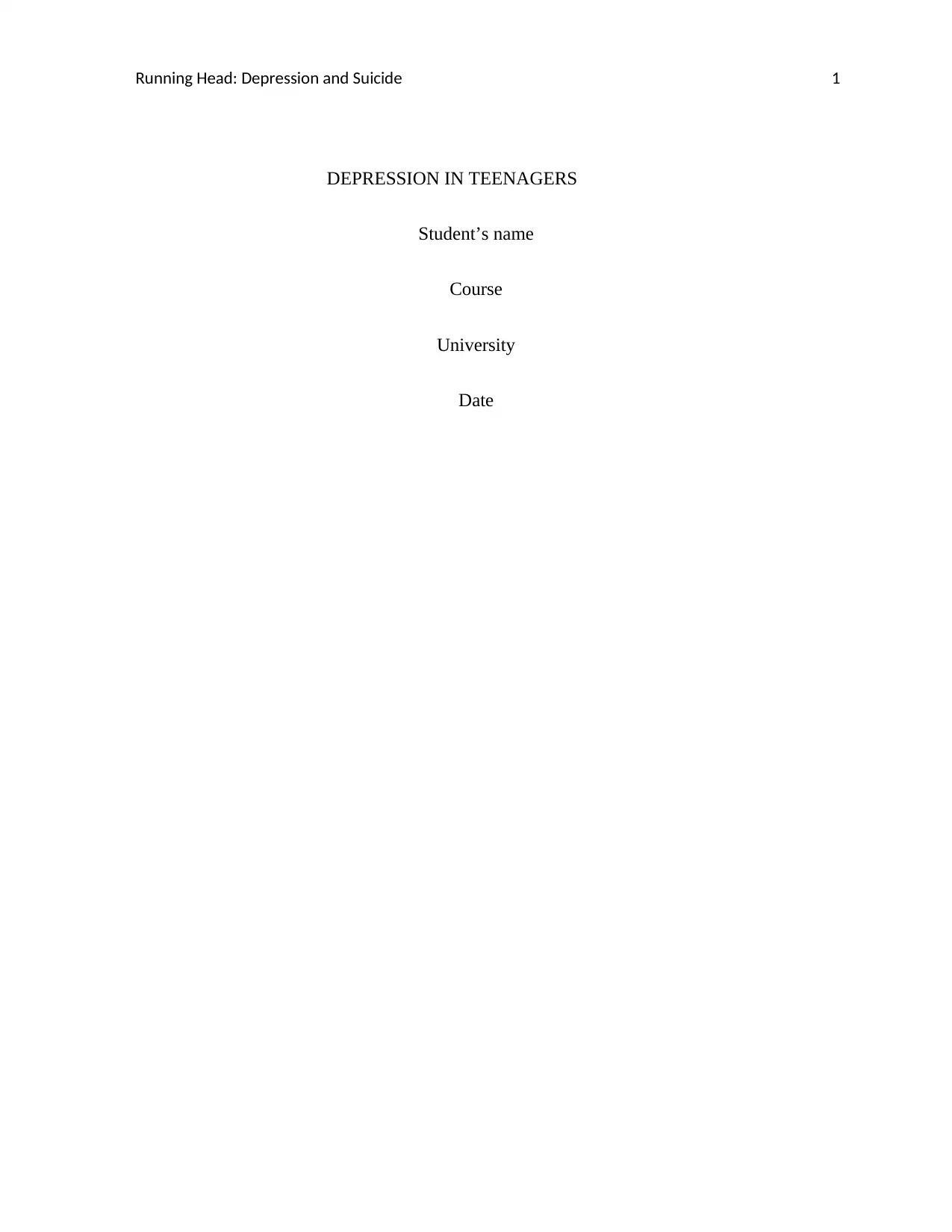
Running Head: Depression and Suicide 1
DEPRESSION IN TEENAGERS
Student’s name
Course
University
Date
DEPRESSION IN TEENAGERS
Student’s name
Course
University
Date
Secure Best Marks with AI Grader
Need help grading? Try our AI Grader for instant feedback on your assignments.
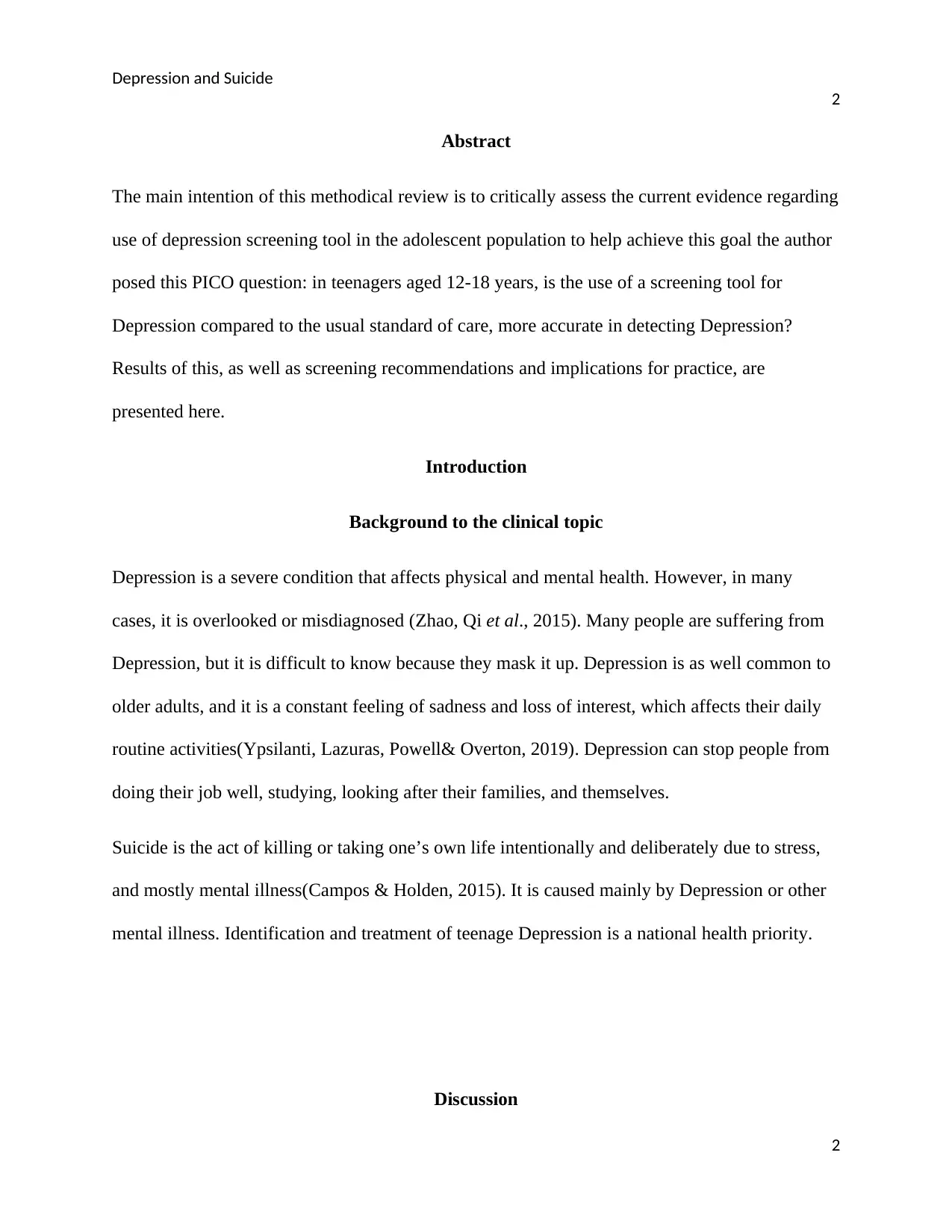
Depression and Suicide
2
Abstract
The main intention of this methodical review is to critically assess the current evidence regarding
use of depression screening tool in the adolescent population to help achieve this goal the author
posed this PICO question: in teenagers aged 12-18 years, is the use of a screening tool for
Depression compared to the usual standard of care, more accurate in detecting Depression?
Results of this, as well as screening recommendations and implications for practice, are
presented here.
Introduction
Background to the clinical topic
Depression is a severe condition that affects physical and mental health. However, in many
cases, it is overlooked or misdiagnosed (Zhao, Qi et al., 2015). Many people are suffering from
Depression, but it is difficult to know because they mask it up. Depression is as well common to
older adults, and it is a constant feeling of sadness and loss of interest, which affects their daily
routine activities(Ypsilanti, Lazuras, Powell& Overton, 2019). Depression can stop people from
doing their job well, studying, looking after their families, and themselves.
Suicide is the act of killing or taking one’s own life intentionally and deliberately due to stress,
and mostly mental illness(Campos & Holden, 2015). It is caused mainly by Depression or other
mental illness. Identification and treatment of teenage Depression is a national health priority.
Discussion
2
2
Abstract
The main intention of this methodical review is to critically assess the current evidence regarding
use of depression screening tool in the adolescent population to help achieve this goal the author
posed this PICO question: in teenagers aged 12-18 years, is the use of a screening tool for
Depression compared to the usual standard of care, more accurate in detecting Depression?
Results of this, as well as screening recommendations and implications for practice, are
presented here.
Introduction
Background to the clinical topic
Depression is a severe condition that affects physical and mental health. However, in many
cases, it is overlooked or misdiagnosed (Zhao, Qi et al., 2015). Many people are suffering from
Depression, but it is difficult to know because they mask it up. Depression is as well common to
older adults, and it is a constant feeling of sadness and loss of interest, which affects their daily
routine activities(Ypsilanti, Lazuras, Powell& Overton, 2019). Depression can stop people from
doing their job well, studying, looking after their families, and themselves.
Suicide is the act of killing or taking one’s own life intentionally and deliberately due to stress,
and mostly mental illness(Campos & Holden, 2015). It is caused mainly by Depression or other
mental illness. Identification and treatment of teenage Depression is a national health priority.
Discussion
2
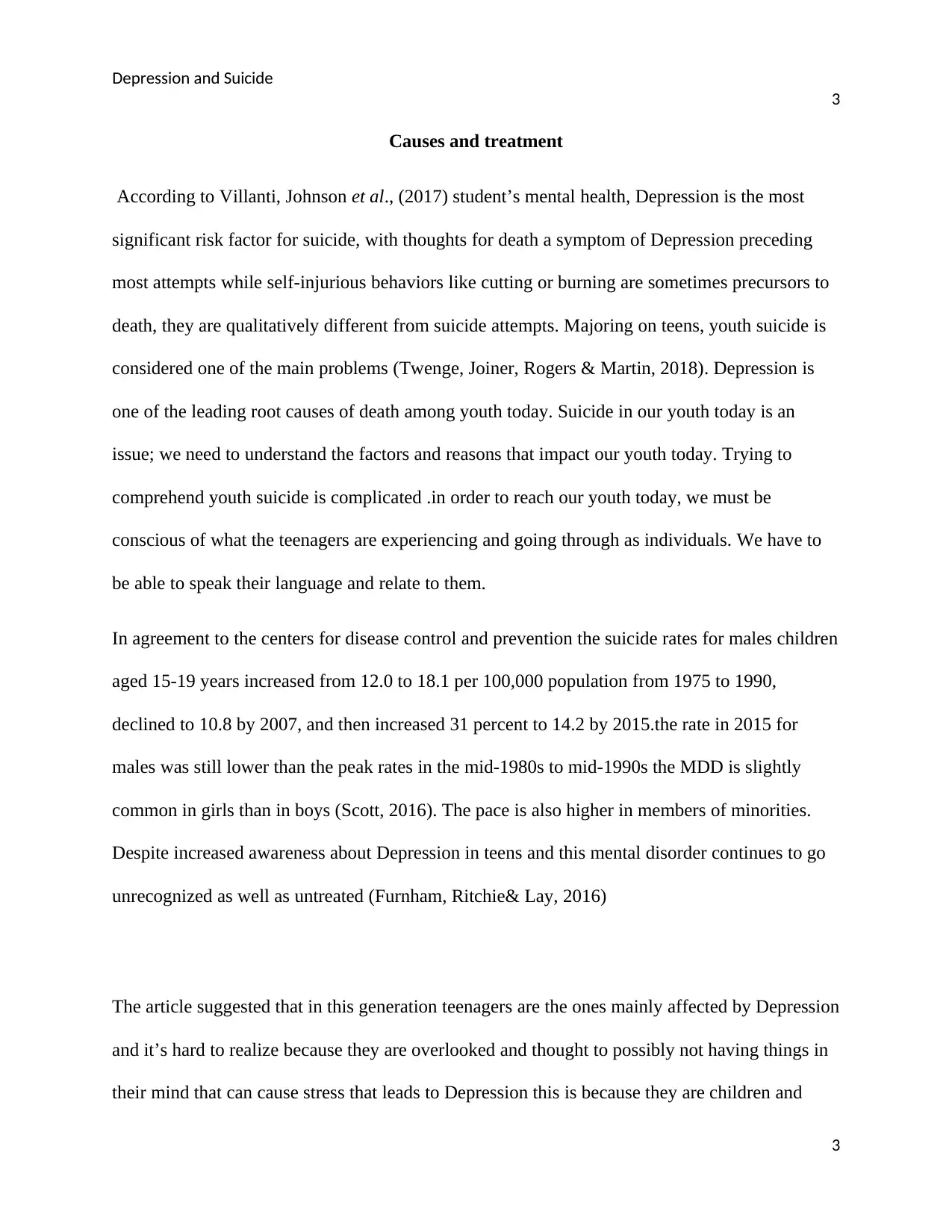
Depression and Suicide
3
Causes and treatment
According to Villanti, Johnson et al., (2017) student’s mental health, Depression is the most
significant risk factor for suicide, with thoughts for death a symptom of Depression preceding
most attempts while self-injurious behaviors like cutting or burning are sometimes precursors to
death, they are qualitatively different from suicide attempts. Majoring on teens, youth suicide is
considered one of the main problems (Twenge, Joiner, Rogers & Martin, 2018). Depression is
one of the leading root causes of death among youth today. Suicide in our youth today is an
issue; we need to understand the factors and reasons that impact our youth today. Trying to
comprehend youth suicide is complicated .in order to reach our youth today, we must be
conscious of what the teenagers are experiencing and going through as individuals. We have to
be able to speak their language and relate to them.
In agreement to the centers for disease control and prevention the suicide rates for males children
aged 15-19 years increased from 12.0 to 18.1 per 100,000 population from 1975 to 1990,
declined to 10.8 by 2007, and then increased 31 percent to 14.2 by 2015.the rate in 2015 for
males was still lower than the peak rates in the mid-1980s to mid-1990s the MDD is slightly
common in girls than in boys (Scott, 2016). The pace is also higher in members of minorities.
Despite increased awareness about Depression in teens and this mental disorder continues to go
unrecognized as well as untreated (Furnham, Ritchie& Lay, 2016)
The article suggested that in this generation teenagers are the ones mainly affected by Depression
and it’s hard to realize because they are overlooked and thought to possibly not having things in
their mind that can cause stress that leads to Depression this is because they are children and
3
3
Causes and treatment
According to Villanti, Johnson et al., (2017) student’s mental health, Depression is the most
significant risk factor for suicide, with thoughts for death a symptom of Depression preceding
most attempts while self-injurious behaviors like cutting or burning are sometimes precursors to
death, they are qualitatively different from suicide attempts. Majoring on teens, youth suicide is
considered one of the main problems (Twenge, Joiner, Rogers & Martin, 2018). Depression is
one of the leading root causes of death among youth today. Suicide in our youth today is an
issue; we need to understand the factors and reasons that impact our youth today. Trying to
comprehend youth suicide is complicated .in order to reach our youth today, we must be
conscious of what the teenagers are experiencing and going through as individuals. We have to
be able to speak their language and relate to them.
In agreement to the centers for disease control and prevention the suicide rates for males children
aged 15-19 years increased from 12.0 to 18.1 per 100,000 population from 1975 to 1990,
declined to 10.8 by 2007, and then increased 31 percent to 14.2 by 2015.the rate in 2015 for
males was still lower than the peak rates in the mid-1980s to mid-1990s the MDD is slightly
common in girls than in boys (Scott, 2016). The pace is also higher in members of minorities.
Despite increased awareness about Depression in teens and this mental disorder continues to go
unrecognized as well as untreated (Furnham, Ritchie& Lay, 2016)
The article suggested that in this generation teenagers are the ones mainly affected by Depression
and it’s hard to realize because they are overlooked and thought to possibly not having things in
their mind that can cause stress that leads to Depression this is because they are children and
3
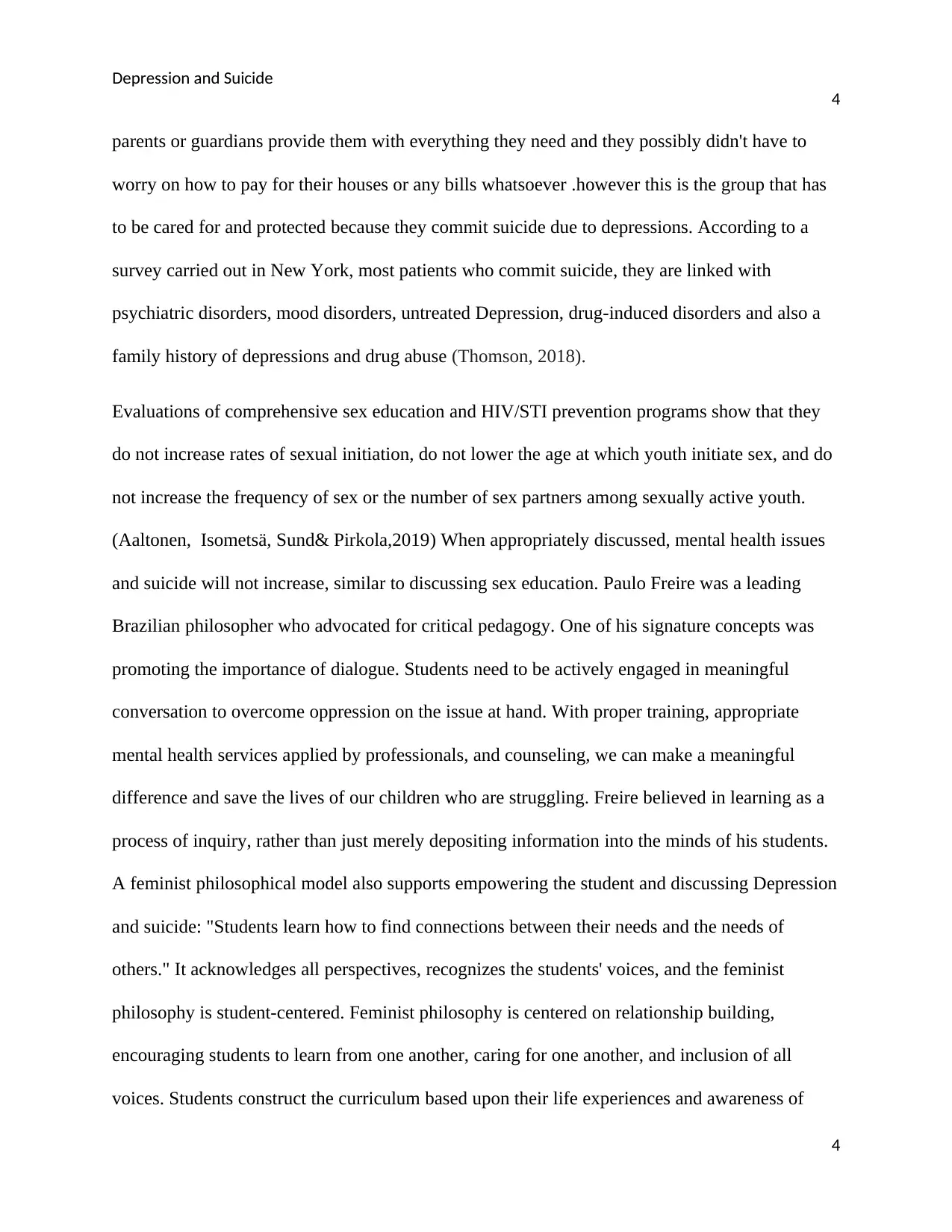
Depression and Suicide
4
parents or guardians provide them with everything they need and they possibly didn't have to
worry on how to pay for their houses or any bills whatsoever .however this is the group that has
to be cared for and protected because they commit suicide due to depressions. According to a
survey carried out in New York, most patients who commit suicide, they are linked with
psychiatric disorders, mood disorders, untreated Depression, drug-induced disorders and also a
family history of depressions and drug abuse (Thomson, 2018).
Evaluations of comprehensive sex education and HIV/STI prevention programs show that they
do not increase rates of sexual initiation, do not lower the age at which youth initiate sex, and do
not increase the frequency of sex or the number of sex partners among sexually active youth.
(Aaltonen, Isometsä, Sund& Pirkola,2019) When appropriately discussed, mental health issues
and suicide will not increase, similar to discussing sex education. Paulo Freire was a leading
Brazilian philosopher who advocated for critical pedagogy. One of his signature concepts was
promoting the importance of dialogue. Students need to be actively engaged in meaningful
conversation to overcome oppression on the issue at hand. With proper training, appropriate
mental health services applied by professionals, and counseling, we can make a meaningful
difference and save the lives of our children who are struggling. Freire believed in learning as a
process of inquiry, rather than just merely depositing information into the minds of his students.
A feminist philosophical model also supports empowering the student and discussing Depression
and suicide: "Students learn how to find connections between their needs and the needs of
others." It acknowledges all perspectives, recognizes the students' voices, and the feminist
philosophy is student-centered. Feminist philosophy is centered on relationship building,
encouraging students to learn from one another, caring for one another, and inclusion of all
voices. Students construct the curriculum based upon their life experiences and awareness of
4
4
parents or guardians provide them with everything they need and they possibly didn't have to
worry on how to pay for their houses or any bills whatsoever .however this is the group that has
to be cared for and protected because they commit suicide due to depressions. According to a
survey carried out in New York, most patients who commit suicide, they are linked with
psychiatric disorders, mood disorders, untreated Depression, drug-induced disorders and also a
family history of depressions and drug abuse (Thomson, 2018).
Evaluations of comprehensive sex education and HIV/STI prevention programs show that they
do not increase rates of sexual initiation, do not lower the age at which youth initiate sex, and do
not increase the frequency of sex or the number of sex partners among sexually active youth.
(Aaltonen, Isometsä, Sund& Pirkola,2019) When appropriately discussed, mental health issues
and suicide will not increase, similar to discussing sex education. Paulo Freire was a leading
Brazilian philosopher who advocated for critical pedagogy. One of his signature concepts was
promoting the importance of dialogue. Students need to be actively engaged in meaningful
conversation to overcome oppression on the issue at hand. With proper training, appropriate
mental health services applied by professionals, and counseling, we can make a meaningful
difference and save the lives of our children who are struggling. Freire believed in learning as a
process of inquiry, rather than just merely depositing information into the minds of his students.
A feminist philosophical model also supports empowering the student and discussing Depression
and suicide: "Students learn how to find connections between their needs and the needs of
others." It acknowledges all perspectives, recognizes the students' voices, and the feminist
philosophy is student-centered. Feminist philosophy is centered on relationship building,
encouraging students to learn from one another, caring for one another, and inclusion of all
voices. Students construct the curriculum based upon their life experiences and awareness of
4
Secure Best Marks with AI Grader
Need help grading? Try our AI Grader for instant feedback on your assignments.
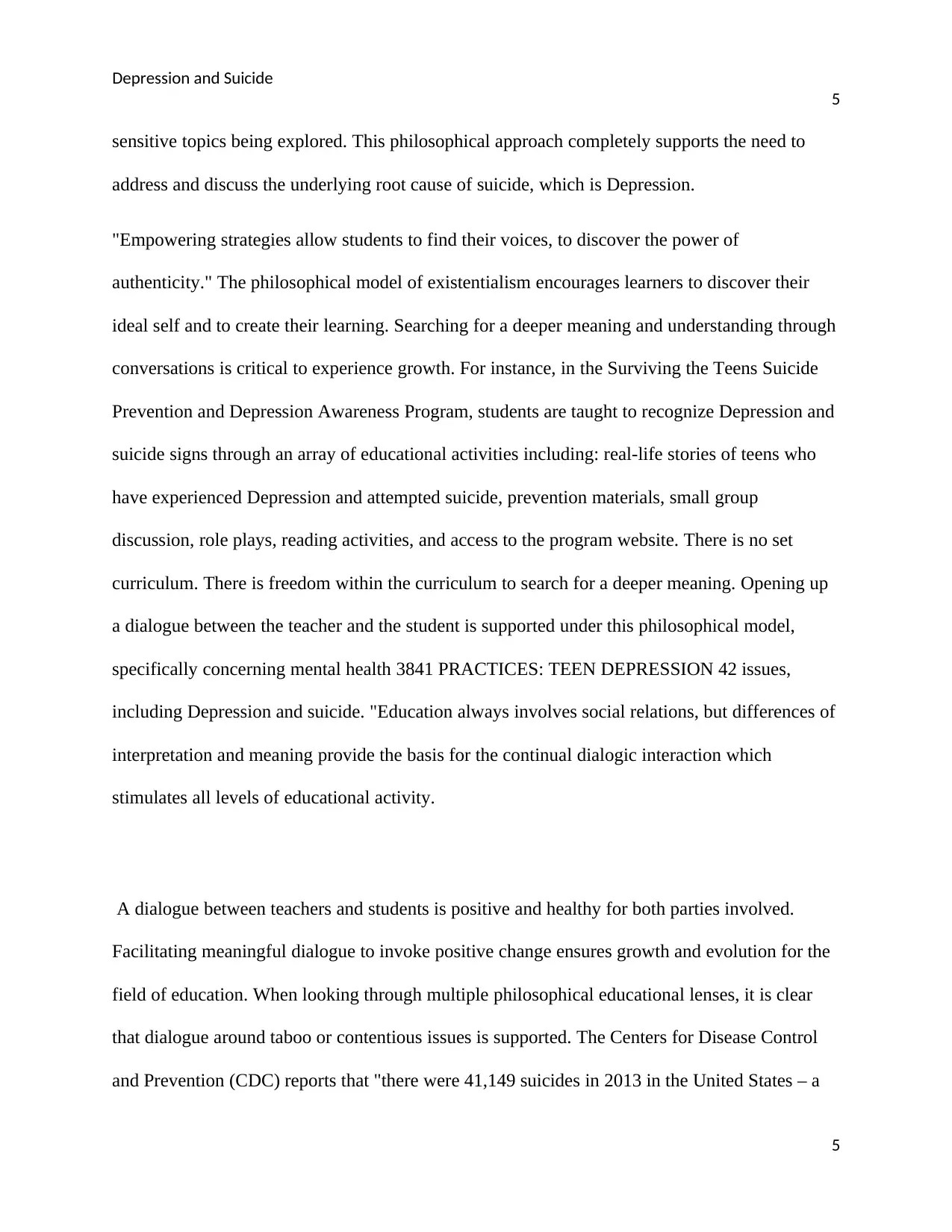
Depression and Suicide
5
sensitive topics being explored. This philosophical approach completely supports the need to
address and discuss the underlying root cause of suicide, which is Depression.
"Empowering strategies allow students to find their voices, to discover the power of
authenticity." The philosophical model of existentialism encourages learners to discover their
ideal self and to create their learning. Searching for a deeper meaning and understanding through
conversations is critical to experience growth. For instance, in the Surviving the Teens Suicide
Prevention and Depression Awareness Program, students are taught to recognize Depression and
suicide signs through an array of educational activities including: real-life stories of teens who
have experienced Depression and attempted suicide, prevention materials, small group
discussion, role plays, reading activities, and access to the program website. There is no set
curriculum. There is freedom within the curriculum to search for a deeper meaning. Opening up
a dialogue between the teacher and the student is supported under this philosophical model,
specifically concerning mental health 3841 PRACTICES: TEEN DEPRESSION 42 issues,
including Depression and suicide. "Education always involves social relations, but differences of
interpretation and meaning provide the basis for the continual dialogic interaction which
stimulates all levels of educational activity.
A dialogue between teachers and students is positive and healthy for both parties involved.
Facilitating meaningful dialogue to invoke positive change ensures growth and evolution for the
field of education. When looking through multiple philosophical educational lenses, it is clear
that dialogue around taboo or contentious issues is supported. The Centers for Disease Control
and Prevention (CDC) reports that "there were 41,149 suicides in 2013 in the United States – a
5
5
sensitive topics being explored. This philosophical approach completely supports the need to
address and discuss the underlying root cause of suicide, which is Depression.
"Empowering strategies allow students to find their voices, to discover the power of
authenticity." The philosophical model of existentialism encourages learners to discover their
ideal self and to create their learning. Searching for a deeper meaning and understanding through
conversations is critical to experience growth. For instance, in the Surviving the Teens Suicide
Prevention and Depression Awareness Program, students are taught to recognize Depression and
suicide signs through an array of educational activities including: real-life stories of teens who
have experienced Depression and attempted suicide, prevention materials, small group
discussion, role plays, reading activities, and access to the program website. There is no set
curriculum. There is freedom within the curriculum to search for a deeper meaning. Opening up
a dialogue between the teacher and the student is supported under this philosophical model,
specifically concerning mental health 3841 PRACTICES: TEEN DEPRESSION 42 issues,
including Depression and suicide. "Education always involves social relations, but differences of
interpretation and meaning provide the basis for the continual dialogic interaction which
stimulates all levels of educational activity.
A dialogue between teachers and students is positive and healthy for both parties involved.
Facilitating meaningful dialogue to invoke positive change ensures growth and evolution for the
field of education. When looking through multiple philosophical educational lenses, it is clear
that dialogue around taboo or contentious issues is supported. The Centers for Disease Control
and Prevention (CDC) reports that "there were 41,149 suicides in 2013 in the United States – a
5
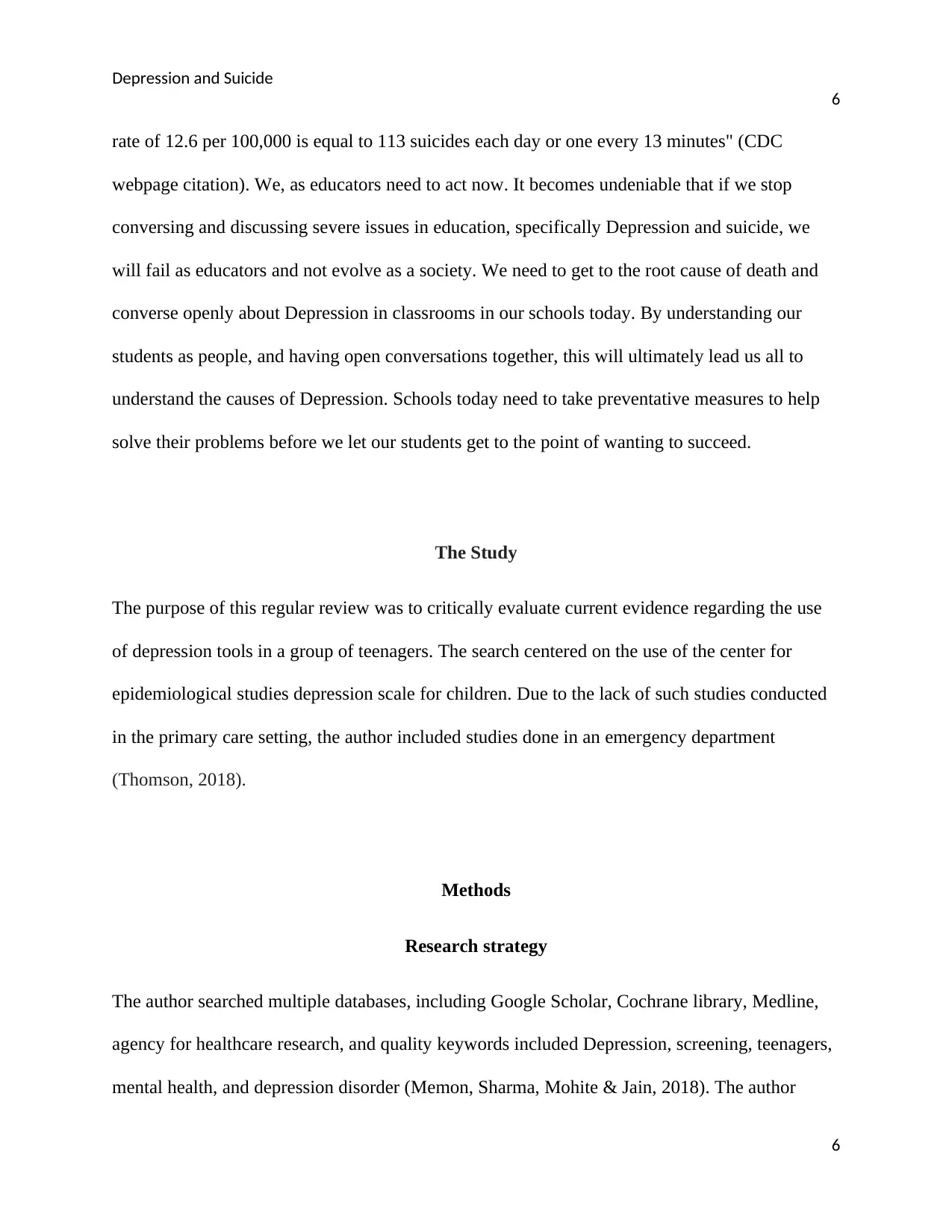
Depression and Suicide
6
rate of 12.6 per 100,000 is equal to 113 suicides each day or one every 13 minutes" (CDC
webpage citation). We, as educators need to act now. It becomes undeniable that if we stop
conversing and discussing severe issues in education, specifically Depression and suicide, we
will fail as educators and not evolve as a society. We need to get to the root cause of death and
converse openly about Depression in classrooms in our schools today. By understanding our
students as people, and having open conversations together, this will ultimately lead us all to
understand the causes of Depression. Schools today need to take preventative measures to help
solve their problems before we let our students get to the point of wanting to succeed.
The Study
The purpose of this regular review was to critically evaluate current evidence regarding the use
of depression tools in a group of teenagers. The search centered on the use of the center for
epidemiological studies depression scale for children. Due to the lack of such studies conducted
in the primary care setting, the author included studies done in an emergency department
(Thomson, 2018).
Methods
Research strategy
The author searched multiple databases, including Google Scholar, Cochrane library, Medline,
agency for healthcare research, and quality keywords included Depression, screening, teenagers,
mental health, and depression disorder (Memon, Sharma, Mohite & Jain, 2018). The author
6
6
rate of 12.6 per 100,000 is equal to 113 suicides each day or one every 13 minutes" (CDC
webpage citation). We, as educators need to act now. It becomes undeniable that if we stop
conversing and discussing severe issues in education, specifically Depression and suicide, we
will fail as educators and not evolve as a society. We need to get to the root cause of death and
converse openly about Depression in classrooms in our schools today. By understanding our
students as people, and having open conversations together, this will ultimately lead us all to
understand the causes of Depression. Schools today need to take preventative measures to help
solve their problems before we let our students get to the point of wanting to succeed.
The Study
The purpose of this regular review was to critically evaluate current evidence regarding the use
of depression tools in a group of teenagers. The search centered on the use of the center for
epidemiological studies depression scale for children. Due to the lack of such studies conducted
in the primary care setting, the author included studies done in an emergency department
(Thomson, 2018).
Methods
Research strategy
The author searched multiple databases, including Google Scholar, Cochrane library, Medline,
agency for healthcare research, and quality keywords included Depression, screening, teenagers,
mental health, and depression disorder (Memon, Sharma, Mohite & Jain, 2018). The author
6
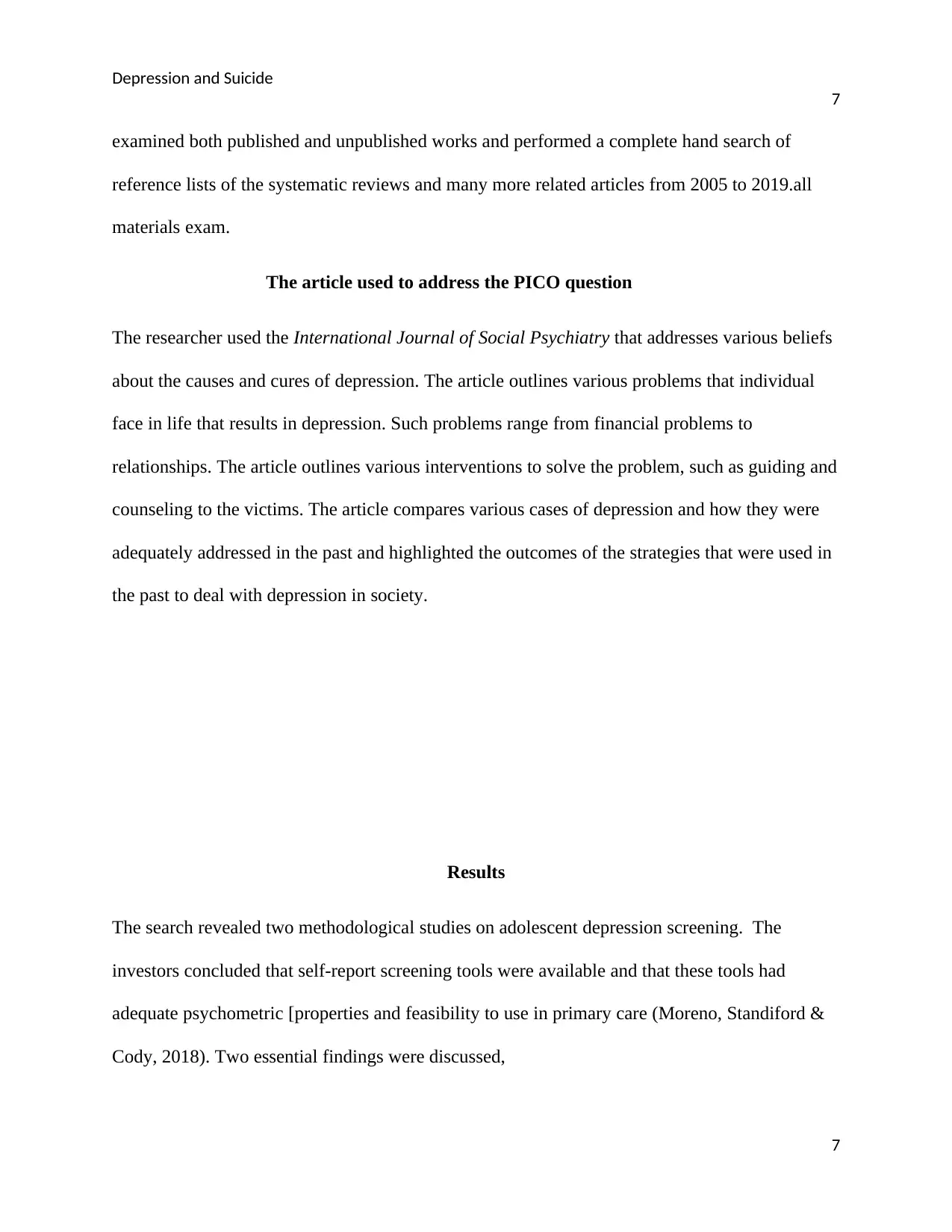
Depression and Suicide
7
examined both published and unpublished works and performed a complete hand search of
reference lists of the systematic reviews and many more related articles from 2005 to 2019.all
materials exam.
The article used to address the PICO question
The researcher used the International Journal of Social Psychiatry that addresses various beliefs
about the causes and cures of depression. The article outlines various problems that individual
face in life that results in depression. Such problems range from financial problems to
relationships. The article outlines various interventions to solve the problem, such as guiding and
counseling to the victims. The article compares various cases of depression and how they were
adequately addressed in the past and highlighted the outcomes of the strategies that were used in
the past to deal with depression in society.
Results
The search revealed two methodological studies on adolescent depression screening. The
investors concluded that self-report screening tools were available and that these tools had
adequate psychometric [properties and feasibility to use in primary care (Moreno, Standiford &
Cody, 2018). Two essential findings were discussed,
7
7
examined both published and unpublished works and performed a complete hand search of
reference lists of the systematic reviews and many more related articles from 2005 to 2019.all
materials exam.
The article used to address the PICO question
The researcher used the International Journal of Social Psychiatry that addresses various beliefs
about the causes and cures of depression. The article outlines various problems that individual
face in life that results in depression. Such problems range from financial problems to
relationships. The article outlines various interventions to solve the problem, such as guiding and
counseling to the victims. The article compares various cases of depression and how they were
adequately addressed in the past and highlighted the outcomes of the strategies that were used in
the past to deal with depression in society.
Results
The search revealed two methodological studies on adolescent depression screening. The
investors concluded that self-report screening tools were available and that these tools had
adequate psychometric [properties and feasibility to use in primary care (Moreno, Standiford &
Cody, 2018). Two essential findings were discussed,
7
Paraphrase This Document
Need a fresh take? Get an instant paraphrase of this document with our AI Paraphraser
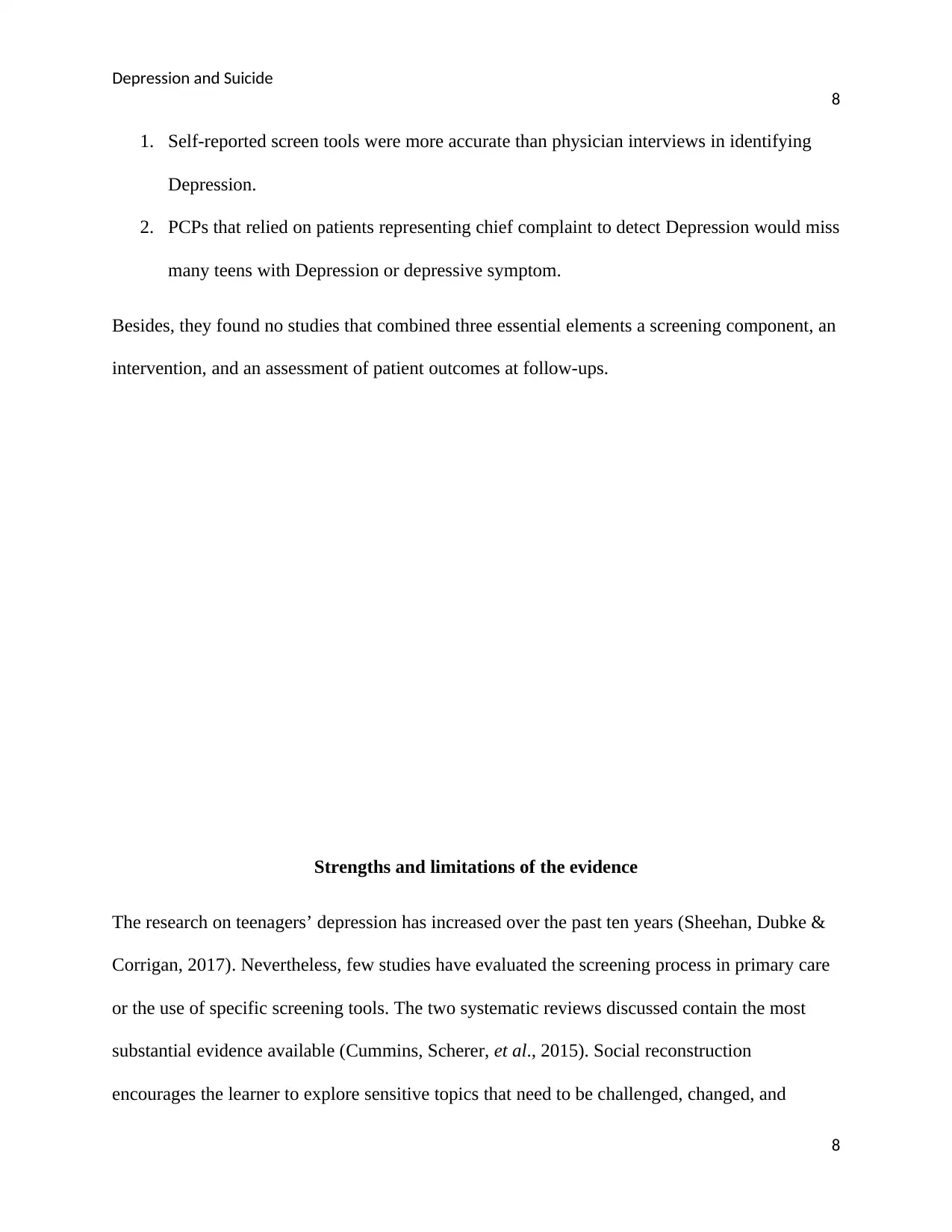
Depression and Suicide
8
1. Self-reported screen tools were more accurate than physician interviews in identifying
Depression.
2. PCPs that relied on patients representing chief complaint to detect Depression would miss
many teens with Depression or depressive symptom.
Besides, they found no studies that combined three essential elements a screening component, an
intervention, and an assessment of patient outcomes at follow-ups.
Strengths and limitations of the evidence
The research on teenagers’ depression has increased over the past ten years (Sheehan, Dubke &
Corrigan, 2017). Nevertheless, few studies have evaluated the screening process in primary care
or the use of specific screening tools. The two systematic reviews discussed contain the most
substantial evidence available (Cummins, Scherer, et al., 2015). Social reconstruction
encourages the learner to explore sensitive topics that need to be challenged, changed, and
8
8
1. Self-reported screen tools were more accurate than physician interviews in identifying
Depression.
2. PCPs that relied on patients representing chief complaint to detect Depression would miss
many teens with Depression or depressive symptom.
Besides, they found no studies that combined three essential elements a screening component, an
intervention, and an assessment of patient outcomes at follow-ups.
Strengths and limitations of the evidence
The research on teenagers’ depression has increased over the past ten years (Sheehan, Dubke &
Corrigan, 2017). Nevertheless, few studies have evaluated the screening process in primary care
or the use of specific screening tools. The two systematic reviews discussed contain the most
substantial evidence available (Cummins, Scherer, et al., 2015). Social reconstruction
encourages the learner to explore sensitive topics that need to be challenged, changed, and
8
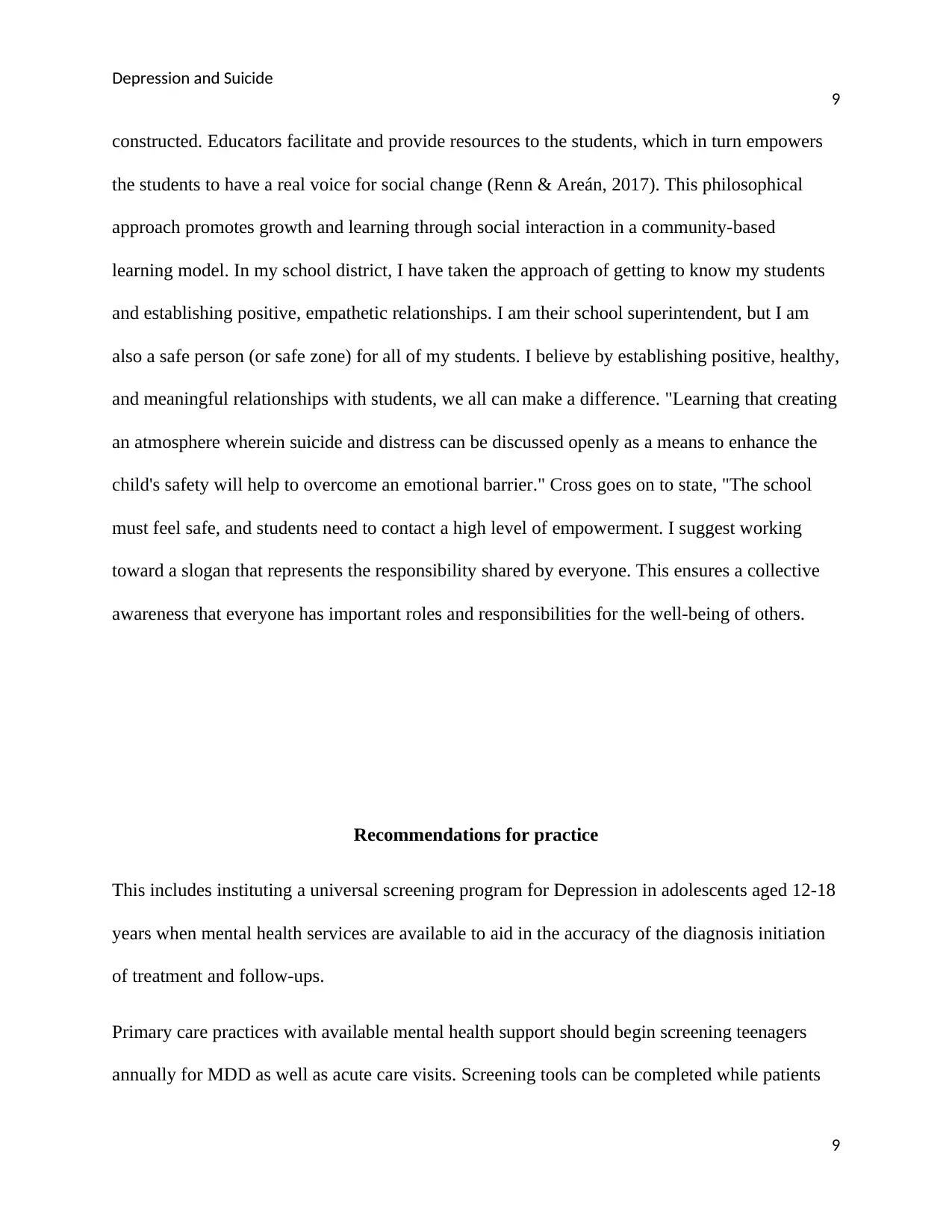
Depression and Suicide
9
constructed. Educators facilitate and provide resources to the students, which in turn empowers
the students to have a real voice for social change (Renn & Areán, 2017). This philosophical
approach promotes growth and learning through social interaction in a community-based
learning model. In my school district, I have taken the approach of getting to know my students
and establishing positive, empathetic relationships. I am their school superintendent, but I am
also a safe person (or safe zone) for all of my students. I believe by establishing positive, healthy,
and meaningful relationships with students, we all can make a difference. "Learning that creating
an atmosphere wherein suicide and distress can be discussed openly as a means to enhance the
child's safety will help to overcome an emotional barrier." Cross goes on to state, "The school
must feel safe, and students need to contact a high level of empowerment. I suggest working
toward a slogan that represents the responsibility shared by everyone. This ensures a collective
awareness that everyone has important roles and responsibilities for the well-being of others.
Recommendations for practice
This includes instituting a universal screening program for Depression in adolescents aged 12-18
years when mental health services are available to aid in the accuracy of the diagnosis initiation
of treatment and follow-ups.
Primary care practices with available mental health support should begin screening teenagers
annually for MDD as well as acute care visits. Screening tools can be completed while patients
9
9
constructed. Educators facilitate and provide resources to the students, which in turn empowers
the students to have a real voice for social change (Renn & Areán, 2017). This philosophical
approach promotes growth and learning through social interaction in a community-based
learning model. In my school district, I have taken the approach of getting to know my students
and establishing positive, empathetic relationships. I am their school superintendent, but I am
also a safe person (or safe zone) for all of my students. I believe by establishing positive, healthy,
and meaningful relationships with students, we all can make a difference. "Learning that creating
an atmosphere wherein suicide and distress can be discussed openly as a means to enhance the
child's safety will help to overcome an emotional barrier." Cross goes on to state, "The school
must feel safe, and students need to contact a high level of empowerment. I suggest working
toward a slogan that represents the responsibility shared by everyone. This ensures a collective
awareness that everyone has important roles and responsibilities for the well-being of others.
Recommendations for practice
This includes instituting a universal screening program for Depression in adolescents aged 12-18
years when mental health services are available to aid in the accuracy of the diagnosis initiation
of treatment and follow-ups.
Primary care practices with available mental health support should begin screening teenagers
annually for MDD as well as acute care visits. Screening tools can be completed while patients
9
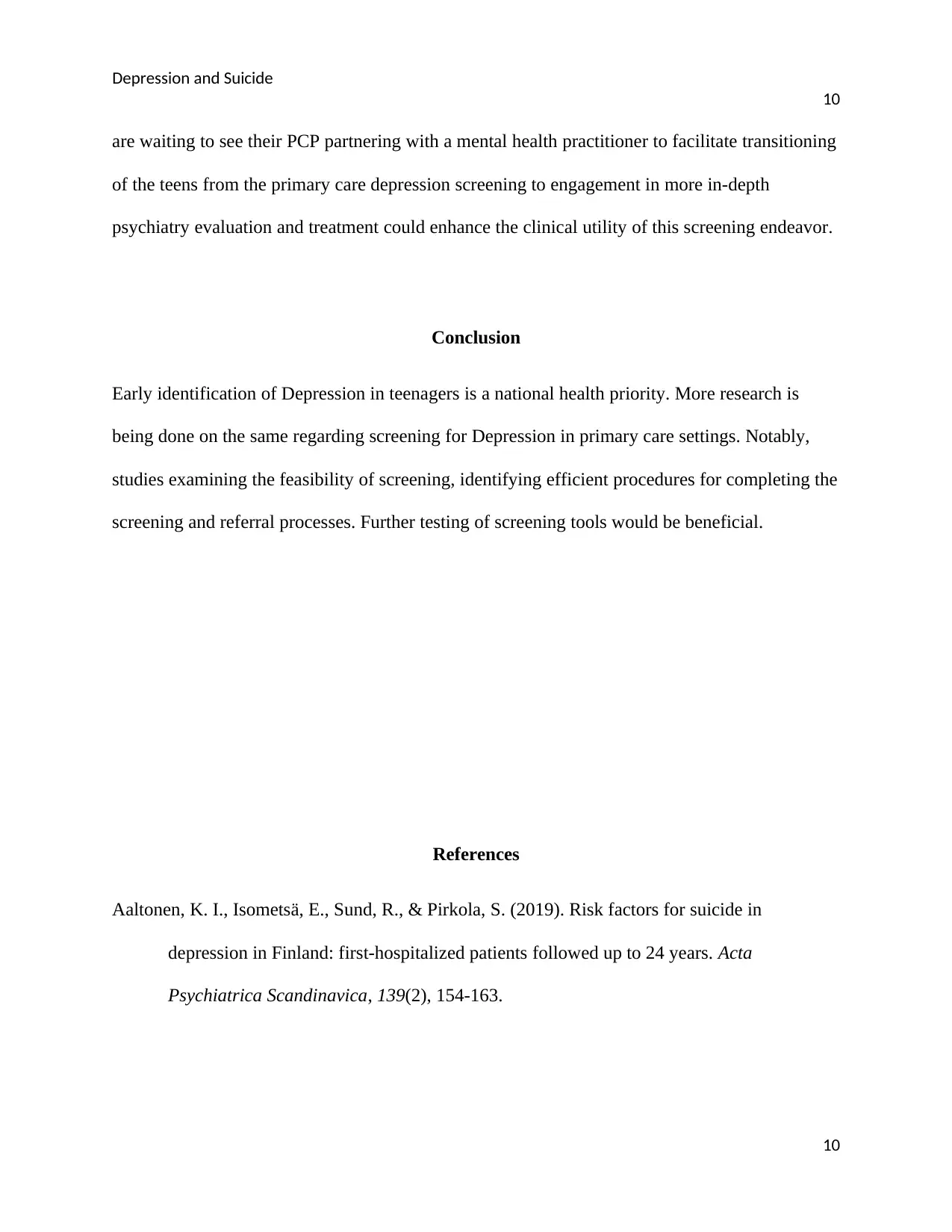
Depression and Suicide
10
are waiting to see their PCP partnering with a mental health practitioner to facilitate transitioning
of the teens from the primary care depression screening to engagement in more in-depth
psychiatry evaluation and treatment could enhance the clinical utility of this screening endeavor.
Conclusion
Early identification of Depression in teenagers is a national health priority. More research is
being done on the same regarding screening for Depression in primary care settings. Notably,
studies examining the feasibility of screening, identifying efficient procedures for completing the
screening and referral processes. Further testing of screening tools would be beneficial.
References
Aaltonen, K. I., Isometsä, E., Sund, R., & Pirkola, S. (2019). Risk factors for suicide in
depression in Finland: first‐hospitalized patients followed up to 24 years. Acta
Psychiatrica Scandinavica, 139(2), 154-163.
10
10
are waiting to see their PCP partnering with a mental health practitioner to facilitate transitioning
of the teens from the primary care depression screening to engagement in more in-depth
psychiatry evaluation and treatment could enhance the clinical utility of this screening endeavor.
Conclusion
Early identification of Depression in teenagers is a national health priority. More research is
being done on the same regarding screening for Depression in primary care settings. Notably,
studies examining the feasibility of screening, identifying efficient procedures for completing the
screening and referral processes. Further testing of screening tools would be beneficial.
References
Aaltonen, K. I., Isometsä, E., Sund, R., & Pirkola, S. (2019). Risk factors for suicide in
depression in Finland: first‐hospitalized patients followed up to 24 years. Acta
Psychiatrica Scandinavica, 139(2), 154-163.
10
Secure Best Marks with AI Grader
Need help grading? Try our AI Grader for instant feedback on your assignments.
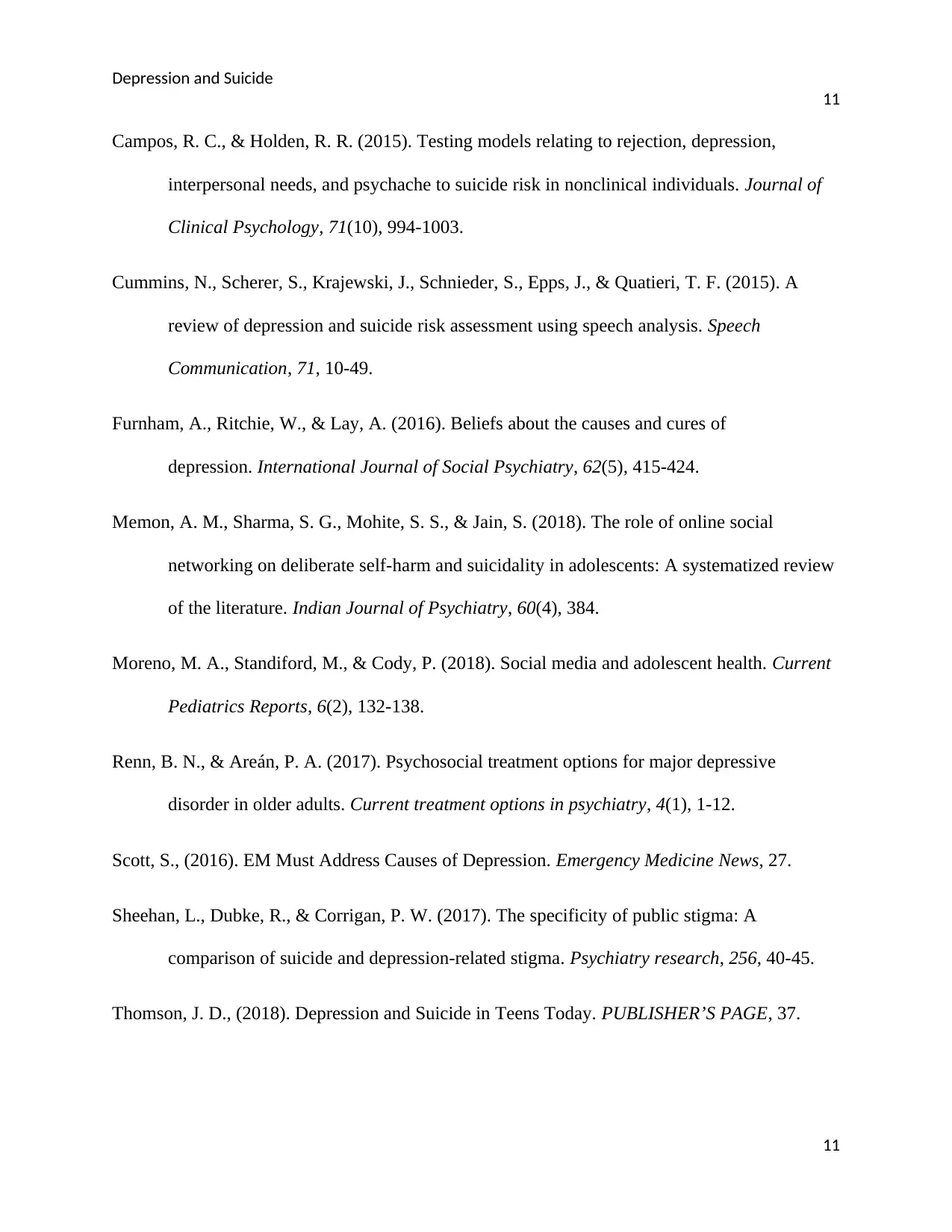
Depression and Suicide
11
Campos, R. C., & Holden, R. R. (2015). Testing models relating to rejection, depression,
interpersonal needs, and psychache to suicide risk in nonclinical individuals. Journal of
Clinical Psychology, 71(10), 994-1003.
Cummins, N., Scherer, S., Krajewski, J., Schnieder, S., Epps, J., & Quatieri, T. F. (2015). A
review of depression and suicide risk assessment using speech analysis. Speech
Communication, 71, 10-49.
Furnham, A., Ritchie, W., & Lay, A. (2016). Beliefs about the causes and cures of
depression. International Journal of Social Psychiatry, 62(5), 415-424.
Memon, A. M., Sharma, S. G., Mohite, S. S., & Jain, S. (2018). The role of online social
networking on deliberate self-harm and suicidality in adolescents: A systematized review
of the literature. Indian Journal of Psychiatry, 60(4), 384.
Moreno, M. A., Standiford, M., & Cody, P. (2018). Social media and adolescent health. Current
Pediatrics Reports, 6(2), 132-138.
Renn, B. N., & Areán, P. A. (2017). Psychosocial treatment options for major depressive
disorder in older adults. Current treatment options in psychiatry, 4(1), 1-12.
Scott, S., (2016). EM Must Address Causes of Depression. Emergency Medicine News, 27.
Sheehan, L., Dubke, R., & Corrigan, P. W. (2017). The specificity of public stigma: A
comparison of suicide and depression-related stigma. Psychiatry research, 256, 40-45.
Thomson, J. D., (2018). Depression and Suicide in Teens Today. PUBLISHER’S PAGE, 37.
11
11
Campos, R. C., & Holden, R. R. (2015). Testing models relating to rejection, depression,
interpersonal needs, and psychache to suicide risk in nonclinical individuals. Journal of
Clinical Psychology, 71(10), 994-1003.
Cummins, N., Scherer, S., Krajewski, J., Schnieder, S., Epps, J., & Quatieri, T. F. (2015). A
review of depression and suicide risk assessment using speech analysis. Speech
Communication, 71, 10-49.
Furnham, A., Ritchie, W., & Lay, A. (2016). Beliefs about the causes and cures of
depression. International Journal of Social Psychiatry, 62(5), 415-424.
Memon, A. M., Sharma, S. G., Mohite, S. S., & Jain, S. (2018). The role of online social
networking on deliberate self-harm and suicidality in adolescents: A systematized review
of the literature. Indian Journal of Psychiatry, 60(4), 384.
Moreno, M. A., Standiford, M., & Cody, P. (2018). Social media and adolescent health. Current
Pediatrics Reports, 6(2), 132-138.
Renn, B. N., & Areán, P. A. (2017). Psychosocial treatment options for major depressive
disorder in older adults. Current treatment options in psychiatry, 4(1), 1-12.
Scott, S., (2016). EM Must Address Causes of Depression. Emergency Medicine News, 27.
Sheehan, L., Dubke, R., & Corrigan, P. W. (2017). The specificity of public stigma: A
comparison of suicide and depression-related stigma. Psychiatry research, 256, 40-45.
Thomson, J. D., (2018). Depression and Suicide in Teens Today. PUBLISHER’S PAGE, 37.
11
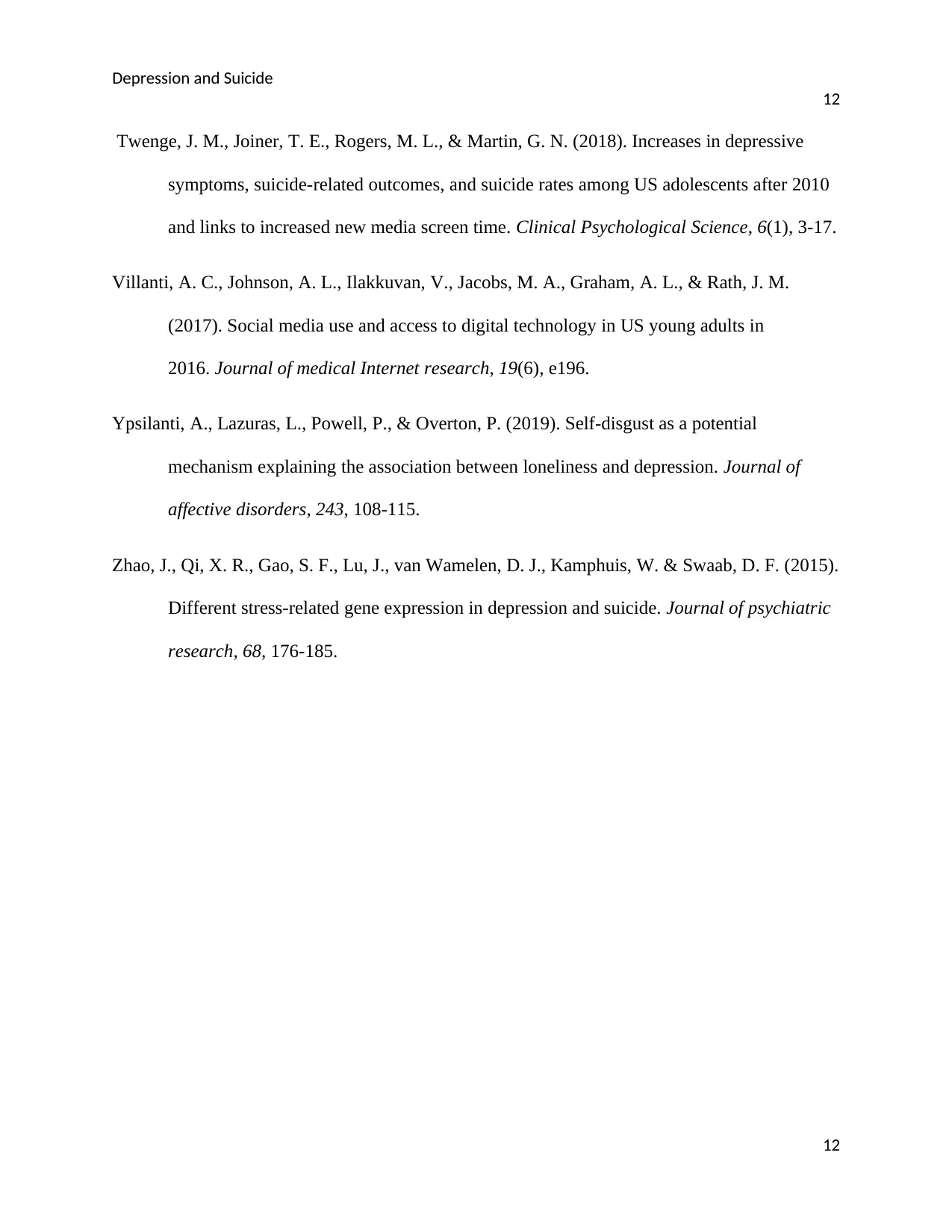
Depression and Suicide
12
Twenge, J. M., Joiner, T. E., Rogers, M. L., & Martin, G. N. (2018). Increases in depressive
symptoms, suicide-related outcomes, and suicide rates among US adolescents after 2010
and links to increased new media screen time. Clinical Psychological Science, 6(1), 3-17.
Villanti, A. C., Johnson, A. L., Ilakkuvan, V., Jacobs, M. A., Graham, A. L., & Rath, J. M.
(2017). Social media use and access to digital technology in US young adults in
2016. Journal of medical Internet research, 19(6), e196.
Ypsilanti, A., Lazuras, L., Powell, P., & Overton, P. (2019). Self-disgust as a potential
mechanism explaining the association between loneliness and depression. Journal of
affective disorders, 243, 108-115.
Zhao, J., Qi, X. R., Gao, S. F., Lu, J., van Wamelen, D. J., Kamphuis, W. & Swaab, D. F. (2015).
Different stress-related gene expression in depression and suicide. Journal of psychiatric
research, 68, 176-185.
12
12
Twenge, J. M., Joiner, T. E., Rogers, M. L., & Martin, G. N. (2018). Increases in depressive
symptoms, suicide-related outcomes, and suicide rates among US adolescents after 2010
and links to increased new media screen time. Clinical Psychological Science, 6(1), 3-17.
Villanti, A. C., Johnson, A. L., Ilakkuvan, V., Jacobs, M. A., Graham, A. L., & Rath, J. M.
(2017). Social media use and access to digital technology in US young adults in
2016. Journal of medical Internet research, 19(6), e196.
Ypsilanti, A., Lazuras, L., Powell, P., & Overton, P. (2019). Self-disgust as a potential
mechanism explaining the association between loneliness and depression. Journal of
affective disorders, 243, 108-115.
Zhao, J., Qi, X. R., Gao, S. F., Lu, J., van Wamelen, D. J., Kamphuis, W. & Swaab, D. F. (2015).
Different stress-related gene expression in depression and suicide. Journal of psychiatric
research, 68, 176-185.
12
1 out of 12
Related Documents
Your All-in-One AI-Powered Toolkit for Academic Success.
+13062052269
info@desklib.com
Available 24*7 on WhatsApp / Email
![[object Object]](/_next/static/media/star-bottom.7253800d.svg)
Unlock your academic potential
© 2024 | Zucol Services PVT LTD | All rights reserved.





